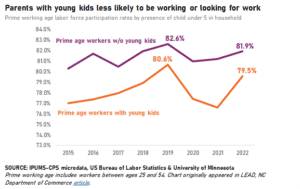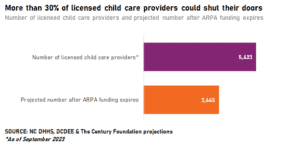Each January, people across the world resolve to make a better version of themselves. Some take on life-changing challenges like quitting smoking; others make more incremental commitments to better their lives, like doing the dishes every night before bed or eating less red meat. Whatever the goal, New Year’s Resolutions commit us to improving ourselves, our relationships, or our lives in some meaningful way. And, by virtue of resolving to our own betterment, we end up changing our lives for the better even if we stumble every now and again.
North Carolina’s early education and child care system is one commitment we can’t come up short on. Families, businesses, and communities rely on child care to function smoothly. If we don’t commit to ensuring child care providers and systems are supported, we could see providers across the state close their doors which would threaten child care services for thousands of families. This year, I want us all to make the collective resolution to keep North Carolina from falling off the child care cliff.
How did we get here?
Nationally, the increase in child care costs have outpaced the cost of other household essentials like groceries, housing, and transportation—and a recent Bank of America report shows that since 2019, parents’ average child care payments are up 32%. In North Carolina, a median two-income earning household can expect to spend about 15% of their income on center-based infant and child care costs, but for a single-income household, this can account for up to 40% of household expenditures. Such high costs price many parents out of the market, which has a cascading effect on child care providers, reducing revenue and the number of staff they can hire and children they can serve.
During the pandemic, federal lawmakers supported children and families across the country by funneling nearly $40 billion into the nation’s child care industry. About $24 billion of these American Rescue Plan Act (ARPA) funds supported Child Care Stabilization Grants to every state. North Carolina received $805 million in stabilization grants, which have supported nearly 4,400 child care programs across the state in 99 counties by offering providers funds to increase staff wages and cover other expenses associated with offering high-quality care. According to NC DHHS data, these grants increased child care capacity to 393,000 spots and supported more than 45,000 child care jobs.
Child care providers serving more children and hiring more staff weren’t the only benefits of the stabilization grants. Increased funding for the industry also allowed more parents to return to work. Parents with young kids are less likely to work or be looking for work than those without children. The stress placed on child care providers during the COVID-19 pandemic made the divide in labor force participation between parents and adults without kids even worse. But the labor force participation of parents with young kids bounced back sharply in 2022, the year after the federal government began disbursing stabilization grants to states. More parents working means family incomes rise, which can pull children out of poverty and improve child health and developmental outcomes.

However, federal Child Care Stabilization Grants started expiring at the end of September 2023, and while the North Carolina legislature extended the deadline for some federal COVID relief funds through June 2024 and increased market rate subsidies, child care centers across the state find themselves in some dire straits.
What has been done?
The legislature’s extension of COVID relief funding deadlines was a step that helped providers continue to attract, retain, and pay their desperately needed workforce—but it only addresses one cost providers incur while operating a center. The legislature’s action to update market rate subsidies to the 2021 rate was another important step in the right direction, but we ultimately still need solutions that holistically address the regional or economic challenges common within the child care industry.
For example, rural communities, which already face a disparate set of economic circumstances, often fall behind their urban and suburban counterparts when states benchmark the cost of child care in market subsidy rate surveys. This means that the cost to operate a rural child care facility is often underestimated and underpaid, resulting in regional rate differences as disparate as $400 per month per child. As a result, whatever limited options exist for parents in a rural community are quickly snuffed out by issues like inflation and broader labor market changes.
Additionally, market subsidy rate surveys measure what parents pay for care in a region, not the actual costs incurred by providers to administer care to children. This means that regardless of geography, child care centers receive less capital than what they need to operate and provide quality care to children.
Altogether, there’s a delicate balance that exists between child care providers and the families they serve. If providers don’t receive enough funds from whatever state or federal programs exist, like stabilization grants or subsidies, they still must make up the rest of the cost of operating a facility. How they make themselves whole is through the cost they attribute to their care, but if they price it too high, parents will have no option but to pull their kids from care, leaving providers in the position to further recoup costs. If they price it too low, their centers will go in the red and they will close.
What can we do?
The Century Foundation estimates that once pandemic-era investments in the child care industry end, about 155,000 children could lose care and nearly 1,800 child care facilities could close. Further, estimates suggests North Carolina parents’ earnings could drop by $416 million and business activity could fall by $485 million. As many families across the state are still trying to keep up with the rising cost of necessities like groceries, transportation, and housing, the cost of falling off the child care cliff is too steep to bear.

The good news is that in the legislative short session this year, there are steps our lawmakers can take to stabilize one of the most critical industries in our state.
- Provide additional funding to extend child care stabilization grants beyond June 2024. Ensuring these grants are still in place beyond this summer can prevent a disastrous impact among providers in North Carolina communities.
- Establish a statewide floor for child care subsidy reimbursements. A statewide reimbursement floor would make reimbursements fairer across geographic lines, eliminating extreme swings in reimbursement rates among providers who operate in neighboring counties. It would also allow providers in primarily rural areas to receive compensation more in line with the actual cost of providing high-quality care to families.
The simple truth is that North Carolina faces a child care crisis, one that every North Carolinian will soon feel the impact if we don’t take action this year. While most of our New Year’s resolutions get abandoned by February, let’s work together to follow through on our resolution to keep our state from falling off the child care cliff.

